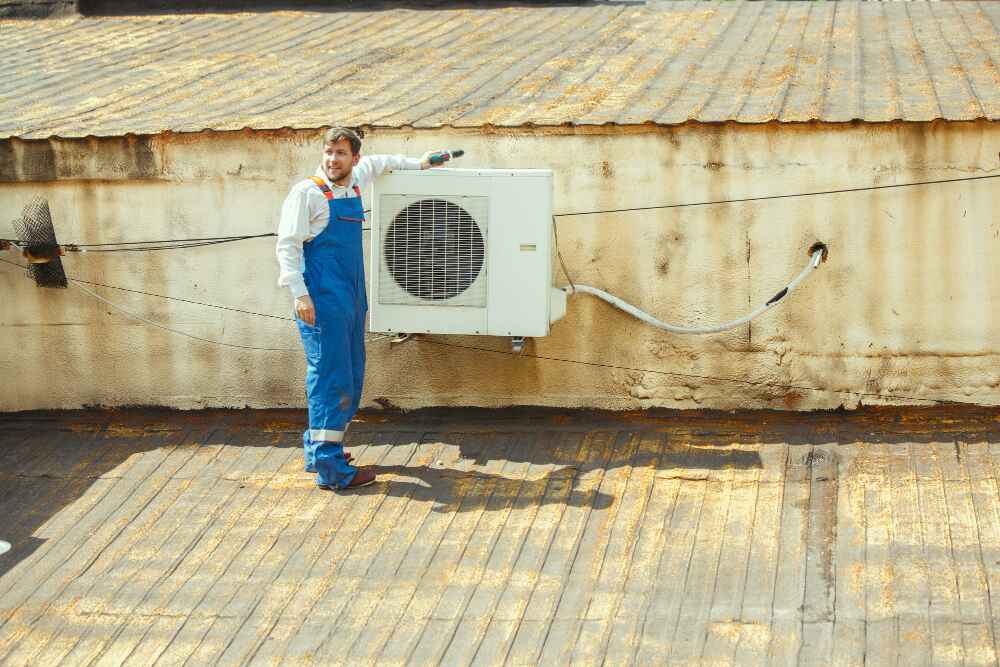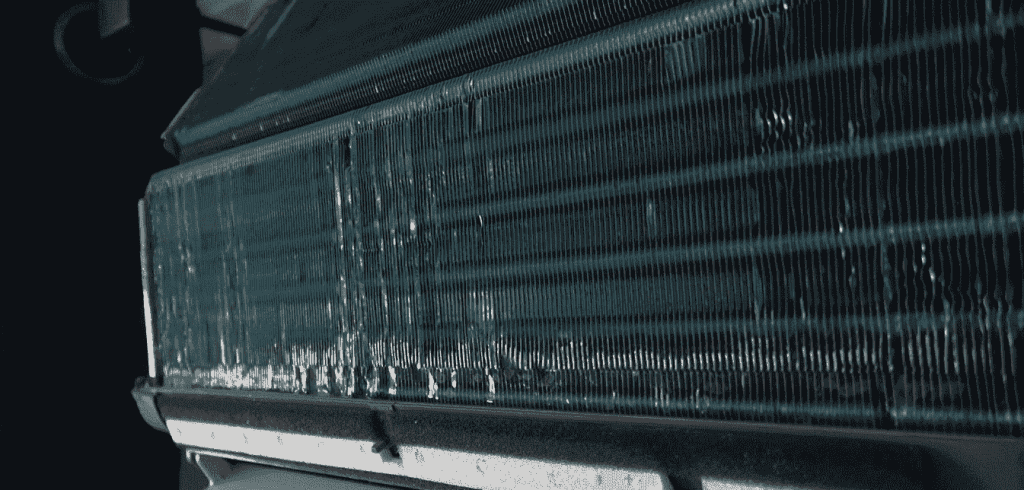Ductless mini splits are rapidly becoming more popular in homes and buildings across the country due to their cost-effective and efficient heating and cooling system options without the need for ductwork.
However, a growing concern among homeowners and business owners is mold growth in these systems. As a leading provider of HVAC services, we feel it’s important to address this concern head-on and clear up any misconceptions.
Mold can be a major issue, but not everyone knows to keep an eye out for it in their mini split system. Even with regular maintenance and filter cleaning, mold can grow in your ductless air conditioner. The bad news is it can get gross and affect your health, but the good news is it’s easy to know when your system needs a deep cleaning.
Our focus here is on avoiding mold and how to head off issues before they get out of hand.
Can Mini Splits Grow Mold?
Yes, mini splits can develop mold growth if not properly maintained. These ductless units, unlike traditional HVAC systems, can trap moisture, dirt, and debris inside the air handlers and evaporators. High humidity in your home makes the problem worse, leading to mildew and mold spores in the air you breathe.

This can cause health problems and make your home environment disgusting. Regular cleaning helps avoid this common issue.
Why Do Mini Splits Develop Mold?
Substandard Installation:
If you’re dealing with persistent mold in your ductless air conditioners or ductless heat pump systems, one likely cause could be improper installation. When a mini split is installed incorrectly, it can lead to moisture buildup within the system. This moisture provides an ideal environment for water vapor to accumulate, creating a breeding ground for mold infestation.
As a result, the mold can grow and spread throughout the inside of the air handler unit. It’s crucial to address these issues promptly to prevent the mold from affecting your indoor air quality and the overall efficiency of your ductless mini split.
Poor Maintenance:
When it comes to mini splits, inadequate maintenance can often be the culprit behind mold issues. If filters are not changed regularly and coils are left dirty, your system becomes a perfect breeding ground for mold spores.

These spores can quickly thrive in such conditions, allowing them to spread throughout the entire system. From personal experience, I’ve seen how neglecting these simple tasks can lead to persistent mold problems. Regular upkeep is crucial to prevent mold from taking over your mini split.
Also Read: How hot can mini split get
Moist Environments:
When a mini split operates in humid environments with high humidity levels, the excess moisture in the air creates the perfect setting for mold growth. Over extended periods of time, the moist environment becomes ideal for mold spores to grow and spread throughout the house.
Without proper ventilation, these conditions pose a significant risk for continuous mold issues. In my experience, ensuring consistent ventilation and managing humidity levels are crucial to prevent the mini split from becoming a breeding ground for mold.
Blocked Drain Line:
f you’ve ever dealt with mold in your mini split, you know how frustrating it can be. One common issue is a clogged condensate drain line. When the drain line gets clogged, standing water starts to backup into the system, creating a moist environment that’s perfect for mold growth.
This environment not only allows mold to thrive but can also cause other problems in your unit. I’ve seen this happen firsthand, and it’s surprising how quickly a clogged drain line can lead to a mold issue, especially when the system isn’t regularly maintained.
Signs of Mold in Your Mini Split
Given below are common symptoms of growing mold in your ductless mini split system.Take appropriate action to prevent mold from spreading in your home.
Unpleasant Odor:
If your mini split starts giving off a cheesy smell like an old gym bag, it could be dirty sock syndrome. This happens when air handlers collect dust, dirt, and moisture, leading to a buildup that can cause mold growth. The odor may start stale but can worsen if not addressed.
This is a common issue with mini splits, so recognizing the symptoms early, like the distinct smell and debris buildup, can prevent more serious complications.
Visible Mold Formation:
When I first noticed the visible mold on my mini split, I had a hunch there was a deeper problem. Using a flashlight, I took a close look inside the air handler and quickly spotted odd-colored splotches on the fins, filter, and even the evaporator coil.
The blower wheel wasn’t spared either, with mold growth creeping in. The black spots on the outside were just the beginning—peering into the opening, I found fully-grown mold hidden deep within.
Low Indoor Air Quality:
If you notice Stagnant and dusty air or allergy like symptoms. It’s a sign mold growth.
Leak and Moisture Near Your Unit:
Moisture around your mini split unit often leads to mold growth. Condensation, leakage, or standing water can create the perfect breeding ground for mildew and fungus. In the summer, the warm, dark spaces inside the HVAC system make it easy for mold to thrive.

Keep an eye out for signs like dampness or water damage near the air handler, as these can indicate a problem with water vapor or excess water that needs immediate attention.
Safeguarding Your Ductless System Against Mold
There are several ways to avoid mold problems, regular maintenance is most vital for your system to run smoothly.Given below are several tasks that will keep you mini split in best conditions.
Regular Maintenance:
Regular maintenance with a licensed HVAC professional is essential to prevent mold growth in ductless mini splits. With preventative maintenance and tune-ups, including cleaning, checking leaks, and deep cleaning of the evaporator coil and air handlers, your system will stay running smoothly.
Addressing moisture buildup from clogged drains or other potential causes is key to avoiding issues. Regular heating and cooling system checkups also improve comfort, lower energy bills, and enhance indoor air quality. An annual tune-up lets certified techs use their expert eyes to spot even the slightest issue.
Change the Air Filter Regularly:
From my experience, dirty air filters in a mini split can quickly lead to mold growth. The filters trap various contaminants that can accumulate over time in ductless systems.
If you don’t change the air filters in your ductless system every one to three months, depending on how much you use it and the environment you’re in, you might notice mold becoming a recurring problem. Regular maintenance of your system is key to preventing mold issues.
Check the Drain Line:
If you’re wondering why your mini split system keeps developing mold, one of the main culprits might be the drain line. Over time, this line can become clogged with dirt and debris, which can cause standing water, ultimately leading to mold growth.
From my experience, it’s crucial to regularly inspect the drain line to catch any buildup early. I’ve found that a quick clean out with a brush or an air compressor is often all that’s necessary to keep things flowing smoothly and prevent any unwanted issues.
Leave It Running:
To prevent mold in your mini split, keep the system turned on. Shutting it off can cause moisture to stay put, leading to problems. The system runs in low-power mode, maintaining temperature and draining moisture.
Cycling it on and off or turning it off might seem efficient, but it’s a mistake. Unlike conventional air conditioning or central furnace setups, your mini split is designed to use less energy while constantly working to dehumidify the space, especially in summer, preventing future mold.
Effects Of Mold In A Mini Split System
Beyond the obvious discomfort of discovering mold in your home, the two biggest concerns you should keep an eye on are.
Respiratory Problems:
When mold starts to form in your mini split, it releases spores into the air, which can lead to respiratory problems. If you’re sensitive to these spores, you might find yourself coughing more often, with a persistent wheezing or a sense of shortness of breath.
These symptoms can develop into more serious conditions like asthma or allergies, making existing health issues worse. In some cases, mold in your mini split can even trigger flu-like symptoms as it settles into your lungs. If you’re exposed to these conditions, it’s crucial to address the issue promptly to avoid further complications.
Structural Concerns:
When you notice mold creeping into your home, it can quickly become more than just an eyesore—it’s a sign of deeper problems. The infestation might start small, but as the spores begin to develop, they thrive in the dampness that your mini split system can create.
This moisture seeps into the drywall, compromising the integrity of your wooden structures. Over time, this can soften the wood, leading to rot that weakens beams and joists. If left unchecked, this cycle of mold and decay can cause significant damage to the very bones of your house, turning a small issue into a major structural concern.
Conclusion
Dealing with mold in your mini split system can be frustrating, especially if you rely on it to keep your home comfortable. Just like any air conditioner or heat pump, your ductless air conditioner units need regular maintenance to stay mold-free. It’s important to be proactive with preventative measures to prevent mold growth in the system.
As someone who has handled this issue in the USA, I recommend scheduling a service appointment for professional cleaning and to have a technician inspect the ductless mini split units. With Airzestify being known as the ductless experts nationwide, their services can help ensure your system stays in top shape with preventative maintenance.
FAQS
How do you stop recurring mold?
To stop recurring mold in your mini split, dry any spillage on the floors and walls after a bath or shower. A DIY moisture meter can help you measure and control humidity, keeping it between 30-60% to prevent mold growth.
How often should a mini split be cleaned?
To prevent mold, inspect and clean the indoor unit and air filter every 4-6 weeks. For safety, always turn off the system before opening the cabinet. Stick to the manufacturer’s recommendations for the best results.
What kills mold permanently?
To remove mould from your mini split, try cleaning with diluted vinegar and a microfibre cloth. If that method doesn’t work, stronger options like bleach or a commercial product can be effective. Sometimes, regular detergent just isn’t enough.

